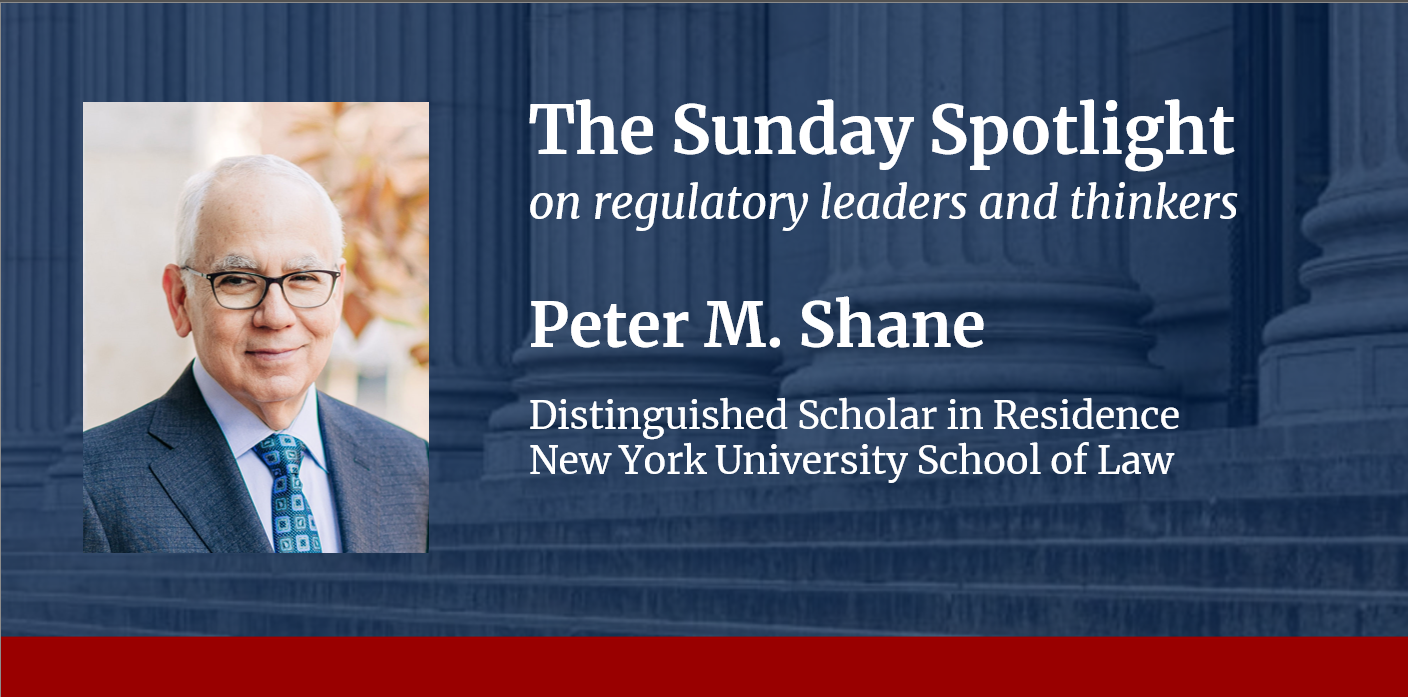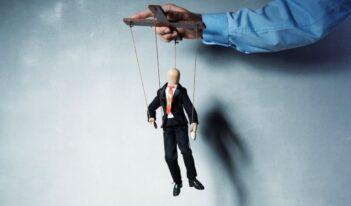
Peter M. Shane discusses recent expansions of presidential power.
In a conversation with The Regulatory Review, administrative and constitutional law scholar Peter M. Shane examines the implications of recent U.S. Supreme Court rulings and Trump Administration executive actions for the separation of powers.
As Shane explains, both the Court’s recent decisions and the second Trump Administration’s actions have redefined the President’s role within the constitutional system, raising concerns about the balance of power among branches of the federal government. For instance, the Court, in its landmark decision on presidential immunity, stated that the President alone holds the “entirety of the executive power,” and the Trump Administration has cut funding to executive agencies established by the U.S. Congress. These developments, Shane explains, demonstrate the Trump Administration’s willingness to wage “open warfare on checks and balances and the separation of powers” in American democracy.
The Court has also expanded the President’s ability to remove the heads of independent regulatory agencies without cause, a change that Shane cautions could degrade the “collegial, often bipartisan deliberation” within agencies or “make it impossible for the agency to function.” To preserve the separation of powers, he calls on Congress to conduct “genuinely rigorous oversight without deference to the President’s party affiliation” and urges the Court to uphold congressional limits on the President’s ability to remove executive agency officials.
Shane is a distinguished scholar in residence and adjunct professor of law at New York University School of Law and is the Jacob E. Davis and Jacob E. Davis II Chair in Law Emeritus at the Moritz College of Law at The Ohio State University. Shane’s public service activities include prior positions with the Administrative Conference of the United States, the Obama-Biden Transition Project, and the Federal Communications Commission. He has also served on the Board of Directors of the American Constitution Society.
A leading scholar in constitutional and administrative law, Shane has authored over 70 law review articles and book chapters, nine books, and essays in The Washington Monthly, The Atlantic, The New York Times, and The Regulatory Review. Shane’s scholarship focuses on the separation of powers, democracy, and the American presidency. In his recent book, Democracy’s Chief Executive: Interpreting the Constitution and Defining the Future of the Presidency, Shane discusses how “aggressive presidentialism” threatens American democracy.
The Regulatory Review is pleased to share the following interview with Peter M. Shane.
The Regulatory Review: What role does the constitutional separation of powers play in American democracy?
Shane: “Separation of powers” is the oversimplified label we give to the distribution in the Constitution of the legislative, executive, and judicial powers among Congress, the executive branch, and the judiciary. It is oversimple because the Constitution also makes each branch partially dependent on the others and gives each branch certain authorities with which to check the other branches’ initiatives.
If the system were working in a state of ideal health, the broad strokes of public policy would be set by the democratically elected legislative branch and implemented by a politically responsive executive. The judiciary would serve democracy by ensuring that the executive branch operates within the bounds of law, including compliance with legislatively mandated processes for promoting public input and accountability. Courts would help to maintain the ideal of each citizen’s equality before the law, which is essential to a democratic government’s claim to moral legitimacy.
TRR: What is the “unitary executive theory”? How has the U.S. Supreme Court embraced it?
Shane: The basic premise of the unitary executive theory is that the President, directly or indirectly, must be able to control all exercises of discretionary power within the executive branch. Until the 1980s, it was a marginal conception of how Article II should be understood. Beyond that premise, however, the theory comes in different flavors. At one end would just be the idea that the President, to control executive branch exercises of discretion, must be able to fire at will any so-called principal officers—high-ranking officials, often agency heads, who must be appointed by the President with the Senate’s consent—within the executive branch. The Roberts Court, however, has adopted—at least in dicta—a much more radical version.
A majority of the Court has endorsed the view that the President “alone composes a branch of government” and holds the “entirety” of executive power. The Court has stated that all officers who wield executive power do so “on the President’s behalf.” What supposedly gives this system “legitimacy and accountability” is that civil servants are tied to the President through “a clear and effective chain of command.” Moreover, the Court has held, the President’s powers of removal and supervision are “conclusive and preclusive.” That is to say, at least in the current Court’s narrative, Congress may not regulate the President’s supervisory powers by statute, and courts may not examine their exercise. This is a radical and, in my judgment, a dangerous and misleading view of Article II power. It is hard to overstate what is wrong with it textually, historically, and institutionally, as I have recently explained.
TRR: You recently defended congressional limits on the President’s authority to remove executive branch officials. How has the Supreme Court addressed presidential removal power in its recent decisions?
Shane: Ninety years ago, in a case called Humphrey’s Executor v. United States, the Supreme Court unanimously held that Congress could impose a good cause requirement on the President’s power to remove even principal administrative officials if their executive functions were performed in service of what the Court called their quasi-adjudicative and quasi-legislative statutory functions—that is, administrative adjudication, information gathering, and rulemaking. Since 2010, however, the Roberts Court has rendered a series of decisions that seem all but inevitably to point towards a majority yearning to overturn Humphrey’s Executor.
The chain started in 2010 with Free Enterprise Fund v. Public Company Accounting Oversight Board, which held that so-called independent administrators—that is, officials protected against at-will presidential discharge—could not oversee or report to other such independent administrators. At least one level or the other had to be dischargeable at will. Ten years later in Seila Law v. Consumer Financial Protection Bureau, the Court held that Article II entitled the President to at-will discharge power over the head of any agency, such as the Consumer Financial Protection Bureau, which is directed by a single agency director, a conclusion the Court reiterated a year later in Collins v. Yellen. These cases left open the constitutionality of protecting the principal officers in such multi-member agencies as the Federal Trade Commission, which was upheld in Humphrey’s Executor.
Hoping to elicit the overturning of Humphrey’s Executor, President Trump has fired a number of officials with statutory tenure protection, including Cathy Harris, chair of the independent Merit Systems Protection Board, and Gwynne Wilcox, a member of the independent National Labor Relations Board (NLRB). Harris and Wilcox succeeded at the district court level in challenging their removal, but the Trump Administration successfully filed an emergency application in the Supreme Court to block their reinstatement until such time as their cases make their way to the Supreme Court for ultimate resolution. In granting the government’s application over the dissent of the Court’s three liberal Justices, the Court clearly indicated that Humphrey’s Executor hangs by a thread. The conservative U.S. Court of Appeals for the Fifth Circuit, for its part, expects the thread to break. It recently affirmed a preliminary injunction barring NLRB proceedings against three employers due to the alleged unconstitutionality of the Board’s statutory independence. In doing so, two members of the split three-judge panel were prepared to proceed even absent a showing that the assertedly unconstitutional tenure protection for Board members caused the employers any harm.
TRR: How might expanding presidential removal power affect the operation and effectiveness of independent regulatory agencies?
Shane: Quite simply, expanding the President’s removal power over independent agencies effectively eliminates their independence. If allowed to fire independent agency members at will, a President intent on bringing a multi-member agency to heel could eliminate the multiplicity of perspectives that is supposed to be the hallmark of collegial, often bipartisan deliberation—or just make it impossible for the agency to function by ensuring the absence of a quorum to do business. Even if the agency is still functional, issues will be less fully ventilated. There will be fewer compromises to reduce extremity in decision-making. Dissents will no longer serve as a kind of monitoring system to alert courts, Congress, and the public to factors the majority may be overlooking or under-weighing in their decisions.
Somewhat ironically, the most robust judicial enumeration of all these advantages of multi-member over single-headed agencies appears in a dissent written by then-Judge Brett Kavanaugh in a U.S. Court of Appeals for the D.C. Circuit case abrogated by the Supreme Court’s decision in Seila Law.
The potential consequences of giving Presidents a comprehensive at-will removal power were well anticipated in 1833 by Justice Joseph Story in his celebrated Commentaries on the Constitution of the United States. Writing in opposition to presidential at-will removal power, he explained: “It is utterly impossible not to feel, that, if this unlimited power of removal does exist, it may be made, in the hands of a bold and designing man, of high ambition and feeble principles, an instrument of the worst oppression and most vindictive vengeance.” Justice Story warned further: “It would convert all the officers of the country into the mere tools and creatures of the President. A dependence, so servile on one individual, would deter men of high and honorable minds from engaging in the public service. And if, contrary to expectation, such men should be brought into office, they would be reduced to the necessity of sacrificing every principle of independence to the will of the chief magistrate, or of exposing themselves to the disgrace of being removed from office.”
I cannot express that thought any better.
TRR: Beyond presidential removal power, how have actions by the Trump Administration—such as dismantling the U.S. Agency for International Development (USAID)—impacted the separation of powers within the federal government?
Shane: The first six months of the Trump Administration have been marked by open warfare on checks and balances and the separation of powers. The President’s primary Article II obligation is to “take care that the laws be faithfully executed.” As Justice Hugo Black wrote in the Court’s famous decision in Youngstown Sheet & Tube Company v. Sawyer, “The President’s power to see that the laws are faithfully executed refutes the idea that he is to be a lawmaker.” Yet President Trump clearly does not see his role that way.
On Day One, President Trump suspended enforcement of the Protecting Americans from Foreign Adversary Controlled Applications Act, popularly known as the “TikTok ban.” As succinctly summarized by Harvard Law School Professor Jack Goldsmith, Congress, by large majorities, “made it unlawful, as of January 19, 2025, for U.S. firms to provide services to distribute, maintain, or update TikTok unless its operation in the United States is severed from Chinese control.” Yet President Trump directed the Justice Department not to enforce the ban for 75 days, a hiatus he has since extended. Attorney General Pam Bondi has asserted that the President has power to do this because it touches on national security, and she has purported to release U.S. companies from any legal obligation to obey. Professor Goldsmith has described these moves as “an astounding assertion of executive power—maybe the broadest I have ever seen any president or Justice Department make, ever, in any context—and that is saying something.” Suspending the law—which Trump has effectively done—is precisely the monarchical practice that the “Take Care” Clause was designed to prohibit.
President Trump has also been assiduous in finding workarounds to evade the constitutional authorities of other branches of government. The power to structure executive branch agencies—both to create and suspend them—belongs exclusively to Congress. Yet, as the USAID example illustrates, President Trump is trying to use reductions in force and other management tools to accomplish reorganizations of a kind previously allowed only under statute. The power of the purse—to determine the levels of federal spending—is likewise purely legislative. Yet the Trump Administration has repeatedly used cutoffs in federal funding as a way of forcing private institutions to adhere to his personal political agenda. As of spring 2025, at least a dozen cases had been filed against the Trump Administration that challenge what appear to be violations of the Impoundment Control Act of 1974. Congress has the exclusive power to regulate commerce with foreign nations. Yet President Trump is using his dubious tariff-setting power to unilaterally recreate the world economic order according to his personal view of international trade.
The Trump Administration has also been no less aggressive with the courts. A recent article in The Washington Post reported that, in a full third of the cases in which courts have issued orders against the Trump Administration, plaintiffs have had grounds to accuse the Administration of “snubbing rulings, providing false information, failing to turn over evidence, quietly working around court orders and inventing pretexts to carry out actions that have been blocked.”
TRR: What role can courts and Congress play in maintaining the separation of powers?
Shane: Congress can start being Congress again and stop being the supine public relations auxiliary of the Trump White House. It should study how a Democratic Congress dealt with the Carter Administration, both in negotiating legislation and in conducting genuinely rigorous oversight without deference to the President’s party affiliation. Congress could effectively resist or even undo virtually every breach of the separation of powers I catalogued earlier if it found the will to do so. Right now, rather than overreaching politically as a reaction to an oppositional Congress, President Trump is just pushing through an open door.
It is the Supreme Court that is going to set the stage for how effectively the judiciary responds to assaults on the separation of powers. The Court plainly does not want to put itself in the position of outright confrontation with President Trump, whose resistance, the members of the Court probably think, could undermine the Court’s legitimacy. But in its apparent zeal to avoid or at least postpone outright defiance by the Trump Administration, the Court has too readily blocked the lower courts from affording relief from Trump Administration lawbreaking. And far from bolstering its own legitimacy, the Court’s seeming obliviousness to President Trump’s authoritarian agenda has chiefly fed the most cynical narrative about the Court’s motivation and politicization.
At a doctrinal level, the developments I would be most eager to see are two-fold: First, the Court should rethink the institutionally dangerous and ahistorical formalism—that is, its pretense that there existed in 1789 a consensus around judicially enforceable categorical boundaries between the branches of government that were intended to insulate executive power from legislative or judicial accountability—embodied in its extreme version of unitary executive theory. Leave Humphrey’s Executor alone. Second, the Court should exercise some procedural discretion in recognizing when arguably discrete presidential actions are part of a coordinated program of sabotaging government. When the President is manifestly intent on burning down a forest, adjudicating the welfare of each individual tree on a case-by-case basis is not going to stop the blaze.
TRR: Looking ahead, what developments or challenges do you anticipate will shape the scope and exercise of presidential power?
Shane: Whether the Trump Administration gets away with its flouting of the Constitution and democratic norms will ultimately be a matter for the American public to decide. That is why President Trump is so anxious to use tactics as complicated as gerrymandering and as blunt as the intimidation of local election officials to stem the tide of potential resistance in the midterm elections. If the public is OK with masked federal agents seizing people off the street, the deployment of military force for ordinary law enforcement, attempting to rewrite American history to erase the contributions of women and people of color, inflicting trauma-inducing cruelty on career civil servants, surveilling college admissions and curricula, and dismantling legislative programs without congressional sanction, all that will continue. My sometime coauthor Hal Bruff once said that the legal precedents Presidents care most about are the examples of what their predecessors got away with. That’s what is at stake. Benjamin Franklin’s conditional characterization of the constitutional form of government launched in 1787—“a republic, if you can keep it”—has never seemed more prescient or, since the Civil War, more foreboding.



